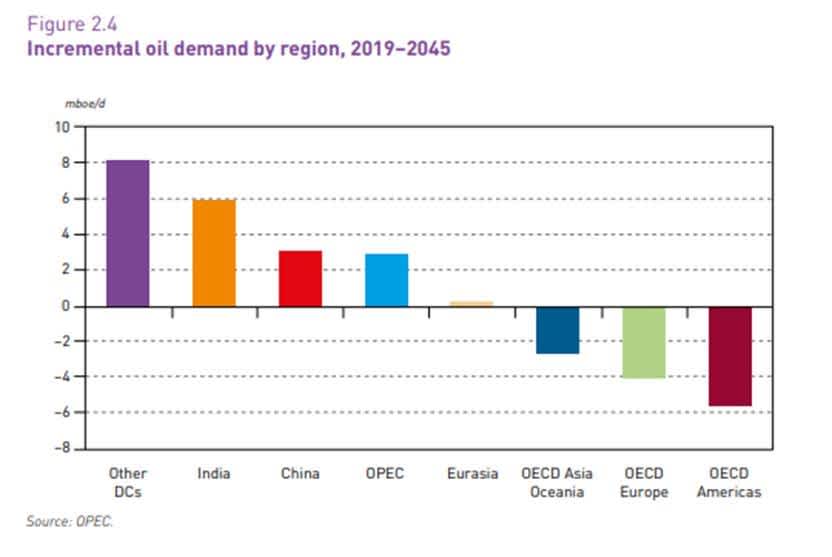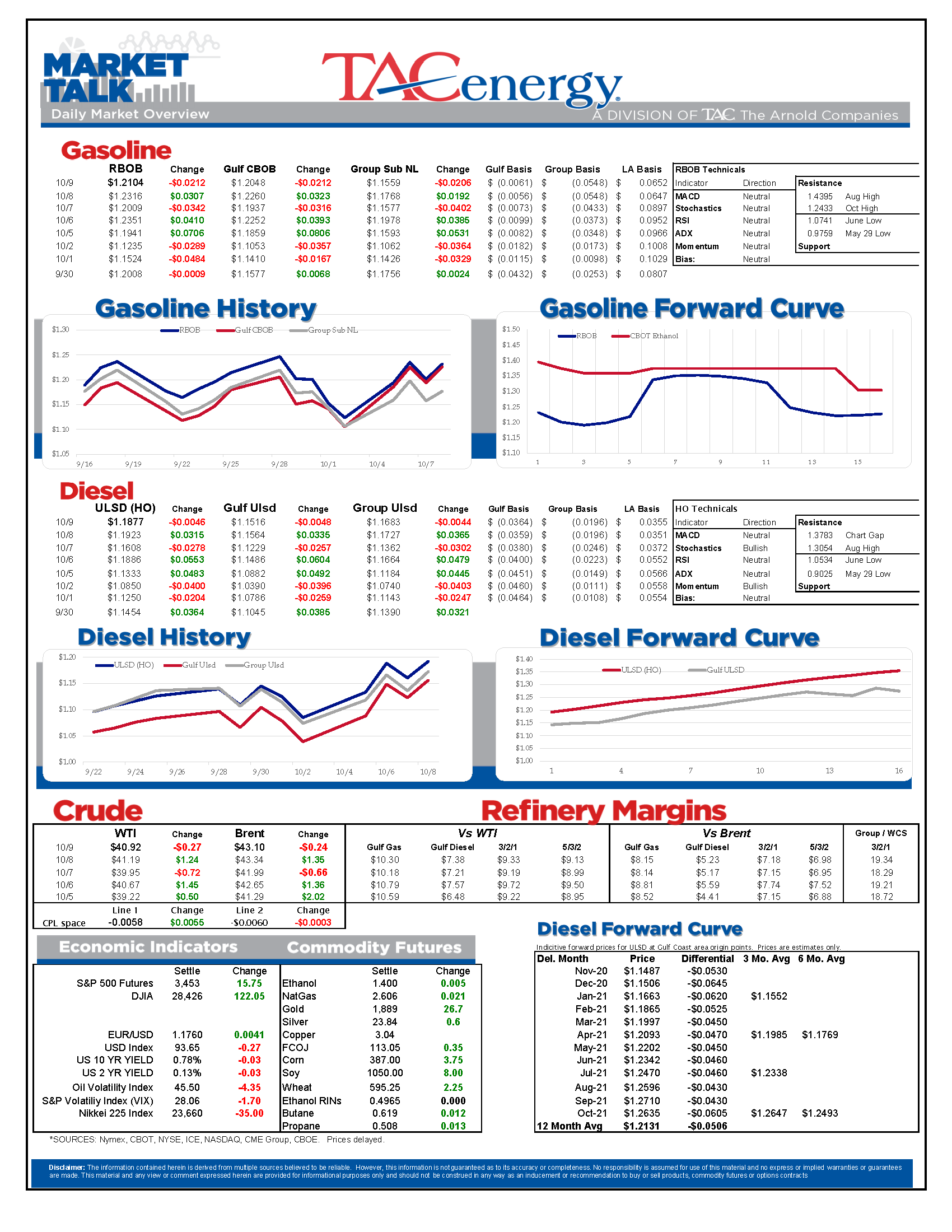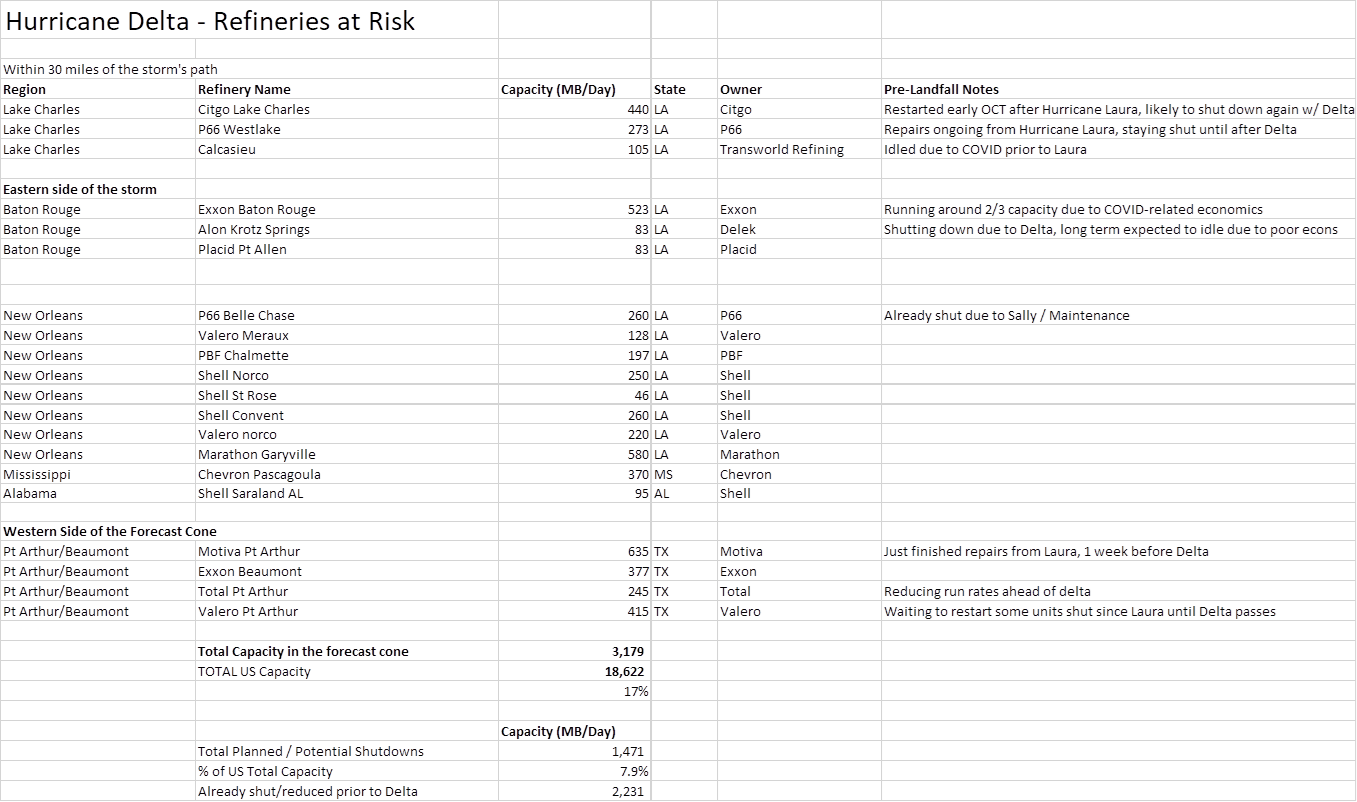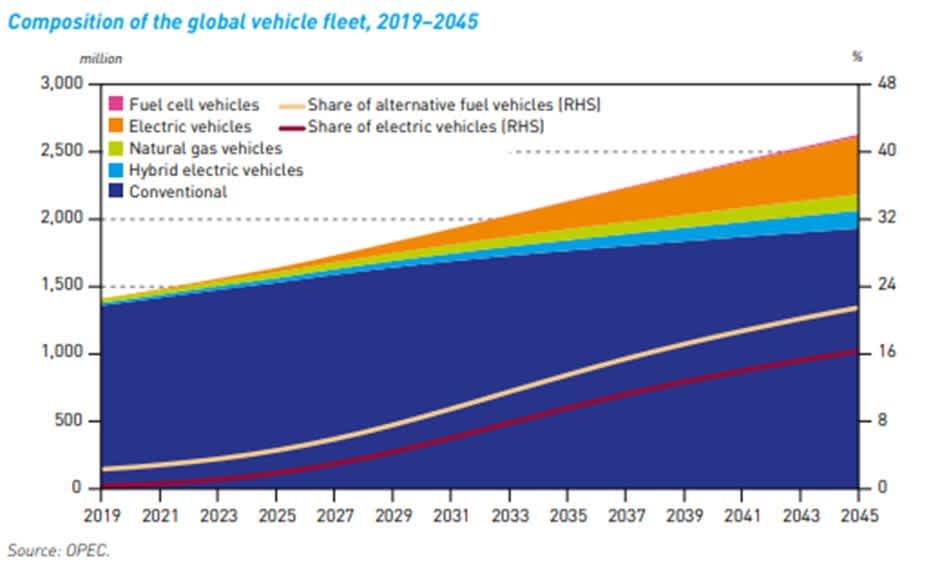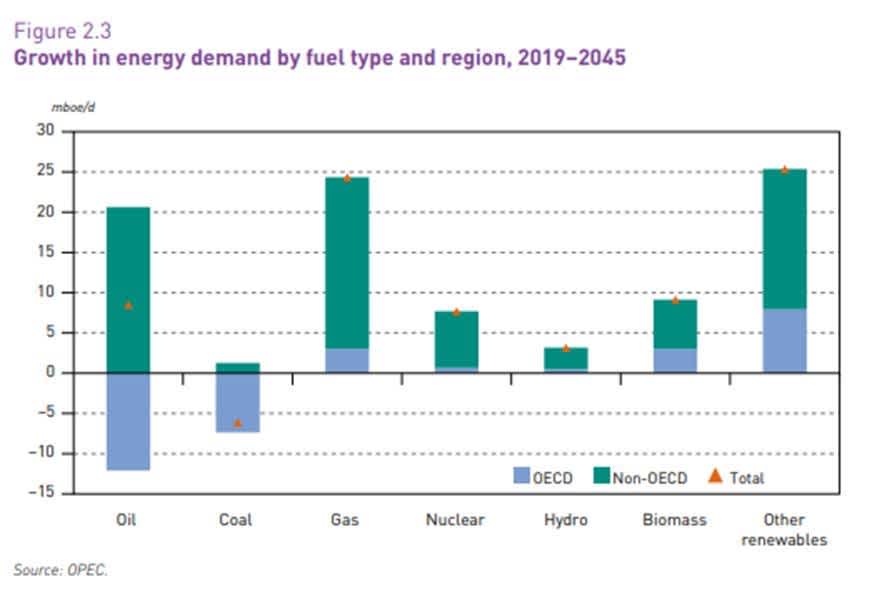The Question Roiling Equity Markets

It’s a weak start to end a strong week for energy prices that have had plenty of back and forth action from the storms swirling around Louisiana and Washington D.C.
Delta looks like it should have relatively minor impacts on supply infrastructure along the gulf coast. Potentially, there should be no noticeable impact on the adjacent markets, as it’s taking a favorable track while it heads towards landfall tonight.
Stimulus or not continues to be the question roiling equity markets this week with a flurry of mixed signals from both the legislative and executive branches of government, and many are expecting more volatility due to uncertainty surrounding the election.
After all the choppiness in the past few weeks, refined product prices find themselves essentially in the middle of the sideways trading range that’s held them since June, leaving the technical outlook neutral near term, while longer term charts still hint at a larger move lower if prices can’t sustain a rally soon.
Delta is currently a Category 3 storm with winds around 120 miles an hour, and is expected to make landfall east of Lake Charles later tonight with winds around 100 miles an hour. It looks like Delta will hit less than 20 miles from where Laura made landfall, with numerous homes and businesses still not repaired from that storm. The good news is Delta is not nearly as powerful as Laura (100 mph vs. 150 mph for Laura) and Lake Charles looks like it will stay on the west side of the storm instead of taking a direct hit like it did six weeks ago. However Delta is a very large storm, so storm surge, tornados and power outages are expected to threaten almost all of the entire Louisiana coast line.
The current path of the storm would essentially thread the needle by hitting right in the middle of a 350 mile stretch of coastline. This is home to 27 refineries, which accounts for 40% of total U.S. capacity. The eye of the storm would not come within 30 miles of any one of those plants. Most of the facilities in Lake Charles and Pt. Arthur aren’t betting that will mean no impact on operations however, with many shutting units until the storm passes, as power outages are still a major concern and have the potential to be much more widespread than the storm itself.
OPEC’s World Oil Outlook highlighted the numerous challenges faced by the industry in the coming years due to COVID and the accelerated push towards renewables in many areas, but still estimates that oil will continue to be the largest piece of the global energy puzzle through 2045. The report also suggests that global oil consumption will continue to grow during the next 25 year stretch, although developed countries like the U.S. may have already seen their peak oil demand, and that a wave of oil refinery consolidation is required to balance the market.
A handful of other highlights from the WOO:
Oil demand growth is expected to recover during the medium-term, linked to demand ‘catching up,' especially in the sectors affected the most by restrictions during the COVID-19 crisis. These include the aviation, road transport and industry sectors.
U.S. tight oil will grow until around 2030, but not as much as previously expected
Crude distillation capacity is expected to increase by 15.6 mb/d until 2045, with a significant slowdown in the rate of required additions
Natural gas will be the fastest-growing fossil fuel between 2019 and 2045
‘Other renewables’ [Solar, Wind, Geothermal] retain the position of fastest growing source of energy in both relative and absolute terms
This article on the concerns over cooking and heating fuel shortages due to the closure of Newfoundland’s only refinery offers a glimpse of the numerous logistical headaches that will come from the rash of closures taking place around the world. In short, there’s still ample supply around the world, but the distribution network will take years to adjust.
One of the more popular of the numerous “clean” energy sources that are making their way through the news lately is Hydrogen. A WSJ article Thursday noted that the biggest challenge facing this alternative fuel is it requires lots of fossil fuels to produce.
Click here to download a PDF of today's TACenergy Market Talk.
News & Views
View All
Energy Markets Are Pointing Modestly Higher To Start Friday’s Session
Energy markets are pointing modestly higher to start Friday’s session, in a meager attempt at a recovery rally at the end of what would be the worst week in over two months if prices settle near current values. The liquidation of speculative bets placed on higher energy prices ahead of the direct conflict between Israel and Iran continues to appear to be the driver of the weakness, and we’ll have to wait and see if this modest bounce is a sign that the liquidation is over, or just a pause before it picks up again. Most contracts remain in a precarious technical position with the potential for a slide towards $70 for WTI and $2.20 for both refined products if the buyers don’t get serious soon.
Stocks are pointing sharply higher after a slowdown in job growth reported in the April Non-Farm payroll report. The BLS reported an increase of 175,000 jobs for the month, down sharply from the 315,000 jobs added in March, and the February & March estimates were revised down a combined 22,000. Both the “official” (U-3) and “real” (U-6) unemployment rates ticked up by .1% to 3.9% and 7.4% respectively. The immediate positive reaction to negative news suggest that the bad news is good news low-interest-rate junkies believe this may help the FED’s dilemma of the US economy being too strong to cut rates. The big jump in equities has not seemed to spill over into energy contracts yet, as crude and refined product contracts changed very little following the report.
San Francisco diesel basis spiked 15 cents Thursday to reach the highest level of any market in the country so far this year at 35 cents over prompt futures. While there aren’t yet any refinery upsets reported to blame the spike on, PBF is undergoing planned maintenance at its Martinez facility, and of course P66 just finished converting its Rodeo plant to RD after Marathon converted its Martinez facility in the past couple of years, meaning there are at most only 2 out of the previous 5 refineries in the region operating near capacity these days. The question now is how quickly barrels can shift north from Southern California which continues to show signs of a supply glut with weak basis values and spot to rack spreads.
PBF continued the trend of Q1 refinery earnings that were sharply lower, but still healthy by longer-term historical standards. The company noted that its Saint Bernard (the parish, not the dog) Renewables facility co-processing at its Chalmette refinery had received provisional approval from CARB to lower its CI scores and help improve the amount of LCFS subsidies it can receive. That facility is operating at 18mb/day which is roughly 86% of its capacity.
Cenovus highlighted the restart of its Toledo and Superior refineries in improved refinery run rates in Q1 2024 vs Q1 2023 and noted that it had ramped up production at units that were slowed down for economic reasons in December and January (you may remember this as the time when midcontinent basis values were trading 50 cents/gallon below futures). The company did note that the January deep freeze slowed operations at Superior, but did not mention any change in operating rates despite numerous upsets at its 50% owned Borger refinery.
Dress rehearsal for a busy hurricane season? So far there are no reports of refinery issues caused by the flooding in the Houston area this week. At this point, most of the flooding appears to be far to the north of the refining hubs on the Gulf Coast but with more storms in the forecast and 88 counties already declaring disaster status, this will be something to watch for the next few days.
Click here to download a PDF of today's TACenergy Market Talk.

Crude Oil Inventories Climbed Above Year-Ago Levels For The First Time In 2024
Sell by May then go away.
The old trading adage looked good for energy markets in 2024 as the new month started off with the biggest daily sell-off of the year so far. WTI and ULSD contracts are now in “rally or else” mode on the charts with sharply lower prices a strong possibility now that technical support layers have broken down. RBOB doesn’t look quite as bearish on the charts, but seasonal factors will now act as a headwind as we’re well into the spring peaking window for gasoline prices, and we’ve already seen a 27 cent drop from the highs. If RBOB can hold above $2.50 there’s a chance to avoid a larger selloff, but if not, a run towards $2.20 for both gasoline and diesel looks likely in the months ahead.
The selling picked up steam following the DOE’s weekly report Wednesday, even though the inventory changes were fairly small. Crude oil inventories continue their steady build and climbed above year-ago levels for the first time in 2024. Demand for refined products remains sluggish, even after accounting for the RD consumption that’s still not in the weekly reports, and most PADDs are following a typical seasonal inventory trend. The Gulf Coast saw a healthy build in diesel inventories last week as the export market slowed for a 3rd straight week. Refinery runs dipped modestly last week following a handful of upsets across the country, but overall rates remain near normal levels for this time of year.
The Transmountain pipeline expansion began operations yesterday, completing a 12-year saga that has the potential to materially change refining economics for plants in the US that relied heavily on discounted Canadian crude to turn profits over the past decade.
The P66 Borger refinery reported another operational upset Monday that lasted a full 24 hours impacting a sulfur recovery unit. Last week the company highlighted how the plant’s fire department helped the surrounding area when the largest wildfire in state history came within feet of the facility.
The EPA approved a new model to determine life cycle carbon intensity scores this week, which cracks open the door for things like ethanol to SAF, which were previously deemed to not reduce emissions enough to qualify for government subsidies. The new model would require improved farming techniques like no-till, cover crop planting and using higher efficiency nitrogen fertilizer to limit the damage done by farms that no longer rotate crops due to the ethanol mandates. Whether or not the theoretical ability to produce SAF comes to fruition in the coming years thanks to the increased tax credit potential will be a key pivot point for some markets that find themselves with too much RD today, but could see those supplies transition to aviation demand.
The FED continues to throw cold water on anyone hoping for a near term cut in interest rates. The FOMC held rates steady as expected Wednesday, but also highlighted the struggles with stubbornly high inflation. The CME’s Fedwatch tool gave 58% odds of at least one rate cut by September before the announcement, and those odds have slipped modestly to 54% this morning.

